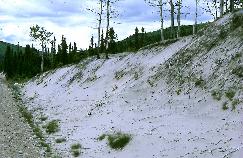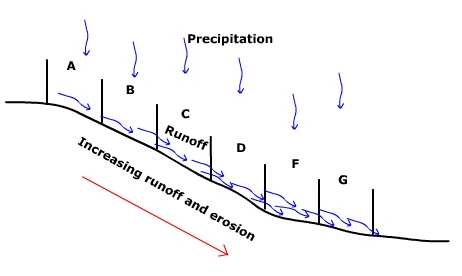Factors Affecting Soil DevelopmentSoil research has shown that soil profiles are influenced by five separate, yet interacting, factors: parent material, climate, topography, organisms, and time. Soil scientists call these the factors of soil formation. These factors give soil profiles their distinctive character. Parent MaterialSoil parent material is the material that soil develops from, and may be rock that has decomposed in place, or material that has been deposited by wind, water, or ice. The character and chemical composition of the parent material plays an important role in determining soil properties, especially during the early stages of development.
Soils developed on parent material that is coarse grained and composed of minerals resistant to weathering are likely to exhibit coarse grain texture. Fine grain soil develop where the parent material is composed of unstable minerals that readily weather. Parent material composition has a direct impact on soil chemistry and fertility. Parent materials rich in soluble ions-calcium, magnesium, potassium, and sodium, are easily dissolved in water and made available to plants. Limestone and basaltic lava both have a high content of soluble bases and produce fertile soil in humid climates. If parent materials are low in soluble ions, water moving through the soil removes the bases and substitutes them with hydrogen ions making the soil acidic and unsuitable for agriculture. Soils developed over sandstone are low in soluble bases and coarse in texture which facilitates leaching. Parent material influence on soil properties tends to decrease with time as it is altered and climate becomes more important. ClimateSoils tend to show a strong geographical correlation with climate, especially at the global scale. Energy and precipitation strongly influence physical and chemical reactions on parent material. Climate also determines vegetation cover which in turn influences soil development. Precipitation also affects horizon development factors like the translocation of dissolved ions through the soil. As time passes, climate tends to be a prime influence on soil properties while the influence of parent material is less. Climate, vegetation, and weatheringClimate affects both vegetative production and the activity of organisms. Hot, dry desert regions have sparse vegetation and hence limited organic material available for the soil. The lack of precipitation inhibits chemical weathering leading to coarse textured soil in arid regions. Bacterial activity is limited by the cold temperatures in the tundra causing organic matter to build up. In the warm and wet tropics, bacterial activity proceeds at a rapid rate, thoroughly decomposing leaf litter. Under the lush tropical forest vegetation, available nutrients are rapidly taken back up by the trees. The high annual precipitation also flushes some organic material from the soil. These factors combine to create soils lacking much organic matter in their upper horizons. Climate, interacting with vegetation, also affects soil chemistry. Pine forests tend to dominate cool, humid climates. Decomposing pine needles in the presence of water creates a weak acid that strips soluble bases from the soil leaving it in an acidic state. Additionally, pine trees have low nutrient demands so few soil nutrients are taken back up by the trees to be later recycled by decaying needle litter. Broadleaf deciduous trees like oak and maple have higher nutrient demand and thus continually recycle soil nutrients keeping soils high in soluble bases. TopographyTopography has a significant impact on soil formation as it determines runoff of water, and its orientation affects microclimate which in turn affects vegetation. For soil to form, the parent material needs to lie relatively undisturbed so soil horizon processes can proceed. Water moving across the surface strips parent material away impeding soil development. Water erosion is more effective on steeper, unvegetated slopes. Effect on soil erosionSlope angle and length affects runoff generated when rain falls to the surface. Examine the diagram below showing the relationship between hill slope position, runoff, and erosion.
The amount of water on a particular hill slope segment is dependent on what falls from precipitation and what runs into it from an upslope hill slope segment. The hill slope in Figure 11.10 has been divided into several segments and the amount of precipitation falling on each segment is the same. As water runs down slope, the water that has accumulated in segment A runs off adding to what falls into segment B by precipitation. The water in B runs into C, and C into D, and so on. The amount of water increases in the down slope direction as water is contributed of water from upslope segments. The velocity of the water increases as well as it moves towards the base of the slope. As a result, the amount and velocity of water, and hence rate of erosion increases as you near the base of the slope. Rather than infiltrating into the soil to promote weathering and soil development, water runs off. Erosion causes stripping of the soil thus preventing parent material to stay in place to develop into a soil. So we should expect to find weakly developed soil at the mid- and near the bottom of the slope. Effect on deposition and soil textureWater velocity not only determines the rate of erosion but the deposition of soil material in suspension too. Figure 11.11 shows the relationship between location and texture. Sites A, B, and C, are located progressively further from the base of a slope. A soil texture triangle is used to illustrate the variation in soil textures at the three sites. Figure 11.11 Location, Deposition and Soil Texture As water empties from a mountain stream, its velocity starts to decrease. The largest size particles, like sand, are the first to drop out of suspension (Site A). Fine, clay size particles can be carried further away from the base of the slope before they are deposited. As a result, coarse textured soils tend to be found near the base of the mountain and fine textured soils are located further away (Site C). Microclimatic effectsHill slope orientation affects the microclimate of a place. As the slope of the surface increases, so does the local sun angle, up to a point. As the local sun angle increases, the intensity of heating increases, causing warmer surface temperatures and, likely, increased evaporation. Orientation of the hill slope is certainly important too. Those slopes which face into the sun receive more insolation than those facing away. Thus inclined surfaces facing into the sun tend to be warmer and drier, than flatter surfaces facing way from the sun. The microclimate also impact vegetation type. |
 Figure 11.9 Stabilized dunes are a form of
Eolian (wind deposited) parent
material (Source: Agriculture Agri-Food Canada)
Figure 11.9 Stabilized dunes are a form of
Eolian (wind deposited) parent
material (Source: Agriculture Agri-Food Canada)

